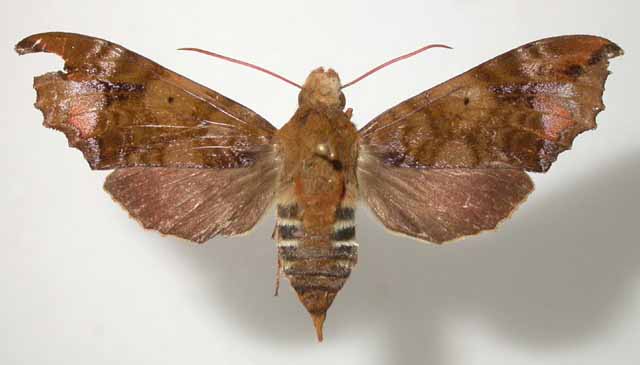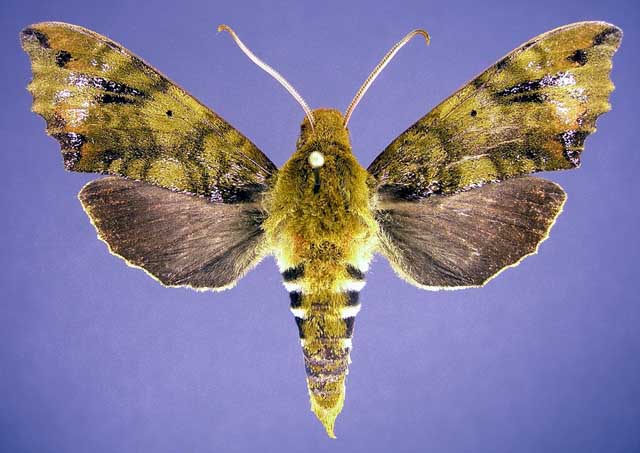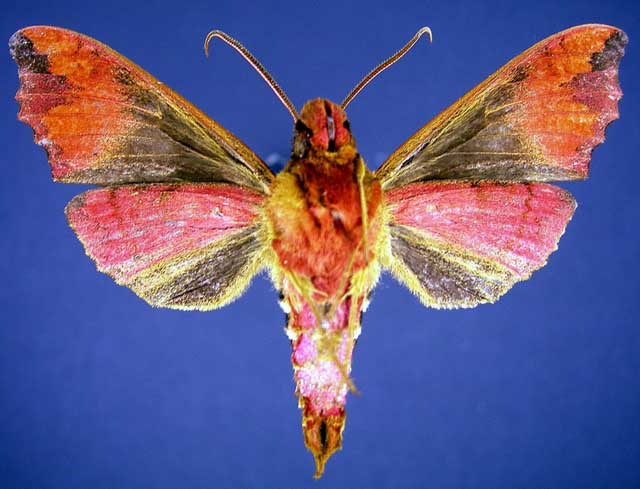Protaleuron rhodogaster
|
|
Updated as per
AN ANNOTATED CHECKLIST OF THE SPHINGIDAE OF BOLIVIA, December 2009
Updated as per personal communication with Jean Haxaire
Updated as per personal communication with Bernhard Wenczel (Oxapampa, Pasco, Peru; 2512m); April 21, 2011
Updated as per personal communication with Jim Vargo (Paradise Lodge, Cosnipata Valley, Cuzco Department, Peru; nectaring 5:45am; 63mm); June 8, 2012
|
Protaleuron rhodogaster
proht-AL-yoo-ronM
roh-doh-GAS-ter
Rothschild & Jordan, 1903

Protaleuron rhodogaster courtesy of
Jean Haxaire
This site has been created by
Bill Oehlke at oehlkew@islandtelecom.com
Comments, suggestions and/or additional information are welcomed by Bill.
TAXONOMY:
Family: Sphingidae, Latreille, 1802
Subfamily: Macroglossinae, Harris, 1839
Tribe: Dilophonotini, Burmeister, 1878
Genus: Protaleuron Rothschild & Jordan, 1903 ...........
Species: rhodogaster Rothschild & Jordan, 1903
|
MIDI MUSIC
.....It's a Wonderful World.....
copyright C. Odenkirk
ON.OFF
<bgsound src="world.mid" LOOP=FOREVER>
|
DISTRIBUTION:
Protaleuron rhodogaster (wingspan: males: 63mm (JV); females: probably larger) flies in
eastern Ecuador;
Peru: Pasco Department (2512m); Cosnipata Valley, Cuzco Department (JV); and
Bolivia: Beni (1450m).
This moth may have a dawn flight pattern. This is suggested by reports from both Bernhard Wenczel and Jim Vargo.

Protaleuron rhodogaster, Paradise Lodge, Cosnipata Valley, Cuzco Department, Peru,
63mm, nectaring at 5:45am, courtesy of Jim Vargo.

Protaleuron rhodogaster, Paradise Lodge, Cosnipata Valley, Cuzco Department, Peru,
63mm, nectaring at 5:45am, courtesy of Jim Vargo.
This species is rarely seen in collections. Jean Haxaire has both
Protaleuron herbini (two specimens) and Protaleuron rhodogaster (only
three specimens known to exist worldwide as of February 2005) in his
collection.
The pronunciation of scientific names is
troublesome for many. The "suggestion" at the top of the page is
merely a suggestion. It is based on commonly
accepted English pronunciation of Greek names and/or some
fairly well accepted "rules" for latinized scientific names.
The suggested pronunciations, on this page and on other pages,
are primarily put forward to assist those who hear with internal
ears as they read.
There are many collectors from different countries whose
intonations and accents would be different.
"Proto" means derived from, and, combined with
"aleuron" which is the Greek word for wheat or meal, probably just
indicates the similarity of members of this genus to the earlier
named genus Aleuron.
The species name comes from the Greek "rhodo" which means red and
"gaster" which means belly. Perhaps this moth's
abdomen is red or pink ventrally?? or it may refer to the wide
stripe of reddish brown "fur" that divides the abdomen on the
dorsal surface.
FLIGHT TIMES:
Bernhard Wenczel writes of the Protaleuron rhodogaster taken by Jose Boettger in Peru, "I forgot to mention WHEN Jose caught that female.
And this is a quite interesting fact. The female flew into the white sheet about ONE HOUR AFTER sunrise. The sun was already shining bright. So
female didnít actually come to the lamp but was either stopped by the sheet or was attracted by it. Jose reported that the moth was flying quite fiercely up
and down the sheet and he had to be fast to get it. This behavior is very unlikely for a moth that was just disturbed and looks now for a new place to hide."
ECLOSION:
SCENTING AND MATING:
EGGS, LARVAE, PUPAE:
Return to U. S. A. Table
Return to Sphingidae Index
Return to Dilophonotini Tribe


